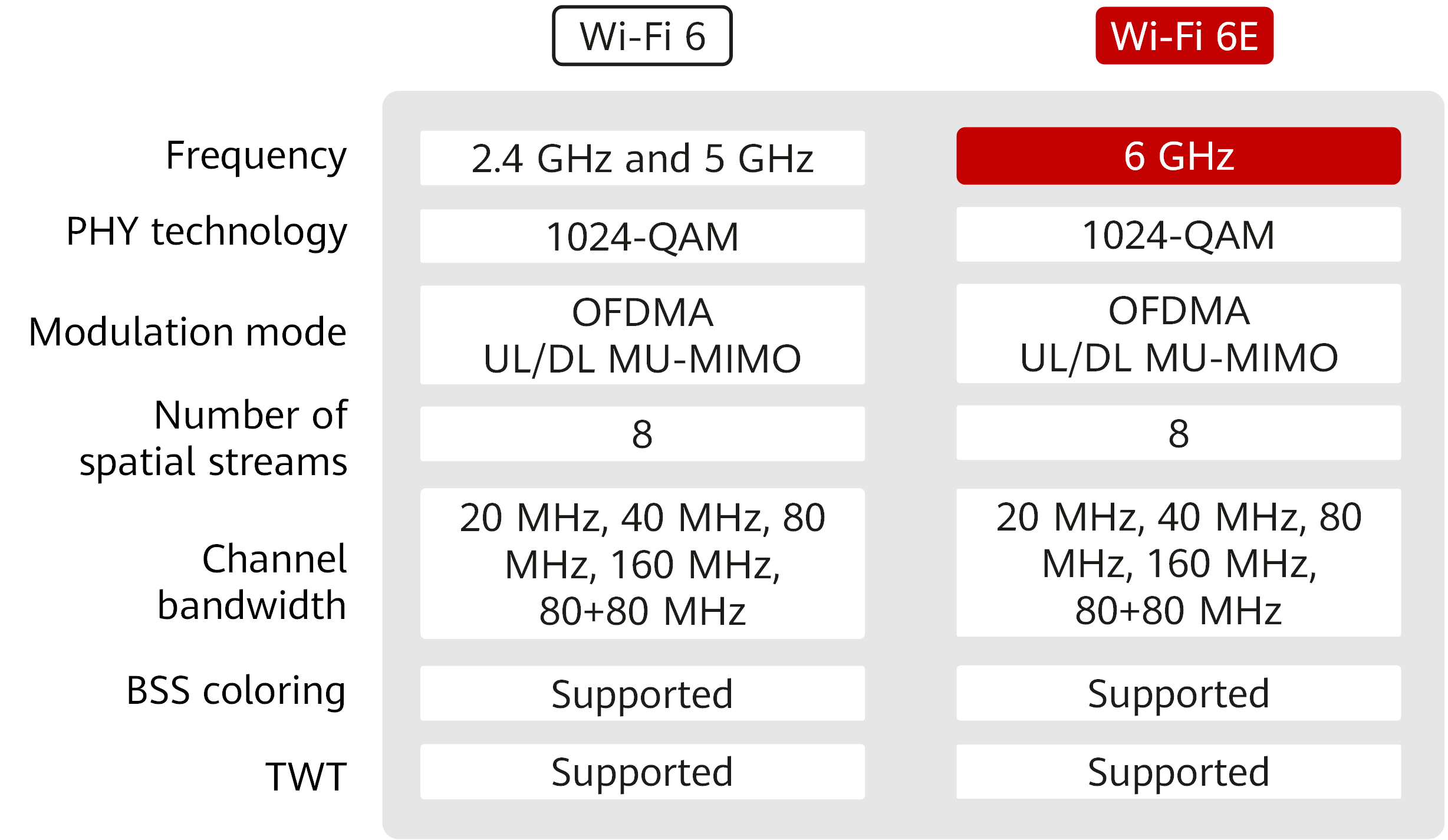What Is WiFi 6E?
WiFi 6E, also known as Wi-Fi 6E, extends the Wi-Fi 6 capabilities to the 6 GHz frequency band, achieving higher concurrency, lower latency, and higher bandwidth. In January 2021, the Wi-Fi Alliance officially announced the Wi-Fi 6E certification.
Wi-Fi 6E vs. Wi-Fi 6
Wi-Fi 6E extends the functions of Wi-Fi 6 to the 6 GHz frequency band. Other Wi-Fi 6 features are still available for Wi-Fi 6E.

Wi-Fi 6E vs Wi-Fi 6
The 6 GHz frequency band provides contiguous spectrum blocks that are globally unified, operating in the range of 5925 MHz to 7125 MHz. With this 1200 MHz spectrum available for use, Wi-Fi 6E devices will be able to work on 7 additional 160 MHz channels, 14 additional 80 MHz channels, 29 additional 40 MHz channels, or 59 additional 20 MHz channels.

6 GHz channels
Regulators in many countries and regions now are opening up the 6 GHz unlicensed spectrum to their citizens, including Brazil, Chile, the European Union, Japan, Mexico, South Korea, Taiwan (China), the United Arab Emirates, the United Kingdom, and the United States.
The 6 GHz frequency band will address various challenges by providing the following:
- High concurrency
Wi-Fi 6E can work on the 6 GHz frequency band, providing an additional 1200 MHz in spectrum resources, which are even more than the total resources provided by the 2.4 GHz and 5 GHz frequency bands. These new spectrum resources alleviate channel congestion and improve the concurrency rate.
- High bandwidth
It is well known that Wi-Fi 6 defines 160 MHz channels to achieve a higher rate. In actual use, however, 160 MHz channels are not so commonly used. Currently, Wi-Fi mainly leverages 2.4 GHz and 5 GHz frequency bands, on which different spectrum ranges are opened in different countries. Nevertheless, it is difficult to provide sufficient 160 MHz channels on these two frequency bands. The 6 GHz frequency band provides additional 160 MHz channels so that the use of 160 MHz bandwidth is made practical. This easily meets high bandwidth requirements.
- Low latency
Conventional Wi-Fi devices support only the 2.4 GHz and 5 GHz frequency bands and therefore cannot operate on 6 GHz channels. In contrast, Wi-Fi 6E devices support the 2.4 GHz, 5 GHz, and 6 GHz frequency bands. That is, only Wi-Fi 6E devices run on the 6 GHz frequency band. Such separation meets the latency requirements of latency-sensitive applications.
Therefore, the 6 GHz frequency band is more suitable for applications that require higher bandwidth and lower latency, such as unified communications, cloud computing, and AR/VR.
As with anything, the 6 GHz frequency band is not perfect. It uses short waves, which adapt to high-speed transmission but are not suitable for long-distance transmission and suffer from high attenuation.
How to Get Wi-Fi 6E
Wi-Fi 6E devices will be backward compatible with Wi-Fi 6 and earlier Wi-Fi standards. However, to leverage new 6 GHz channels available in Wi-Fi 6E, devices must support the 6 GHz frequency band. That is, Wi-Fi 6E features are available only when Wi-Fi 6E-capable terminals (such as PCs or smartphones) work with Wi-Fi 6E-capable APs.
Do You Need to Upgrade Your Network to Wi-Fi 6E?
Regarding the 6 GHz frequency band for Wi-Fi use, most countries and regions are still in the survey or wait-and-see phase. There are only few terminals supporting the 6 GHz frequency band now. In the next three to five years, Wi-Fi terminals will still mainly support 2.4 GHz and 5 GHz frequency bands. According to the technology evolution cycles of previous Wi-Fi generations, it usually takes three to four years for a new Wi-Fi standard to reach a 50% penetration rate. Considering the varying 6 GHz frequency band open-up time in countries and regions, the Wi-Fi 6E popularization period may be longer. Therefore, unless otherwise required, just use your Wi-Fi 6 products to enjoy optimal Wi-Fi 6 network experience, without having to wait for 6 GHz-capable devices.
- Author: Zhou Xia
- Updated on: 2022-04-02
- Views: 12715
- Average rating:







